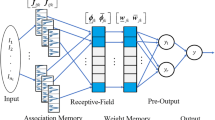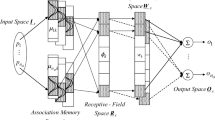Abstract
This study aims to propose a more efficient control algorithm for the chaotic system synchronization. In this study, a novel wavelet cerebellar model articulation controller (WCMAC) is proposed, which incorporates the wavelet decomposition property with a cerebellar model articulation controller (CMAC). This WCMAC is a generalization network; in some special cases, it can be reduced to a wavelet neural network, a neural network and a conventional CMAC. Then, an adaptive wavelet cerebellar model articulation control system (AWCCS) is proposed to synchronize a unified chaotic system. In this AWCCS, WCMAC is the main controller utilized to mimic a perfect controller and the parameters of WCMAC are online adjusted by the derived adaptive laws; and a compensation controller is designed to dispel the residual of the approximation error for achieving \( H^{\infty } \) robust performance. The derived AWCCS is then applied to the chaotic system synchronization control. Finally, the effectiveness of the proposed control system is demonstrated through simulation results.







Similar content being viewed by others
References
Ott E, Grebogi C, Yorke JA (1990) Controlling chaos. Phys Rev Lett 64:1196–1199
Chen G (1999) Controlling chaos and bifurcations in engineering systems. CRC Press, Boca Raton
Jiang ZP (2002) Advanced feedback control of the chaotic Duffing equation. IEEE Trans Circuits Syst I 49:244–249
Wai RJ, Lin YW, Yang HC (2011) Experimental verification of total sliding-mode control for Chua’s chaotic circuit. IET Circuits Devices Syst 5:451–461
Hugues-Salas O, Shore KA, Banks SP (2008) Stabilisation of chaotic dynamics in semiconductor lasers with optical feedback using optimal control. IET Optoelectron 2:231–240
Andreyev YV, Dmitriev AS, Efremova EV, Anagnostopoulos AN (2003) Chaotic signal processing: information aspects. Chaos Solitons Fractals 17:531–544
Terry JR, VanWiggeren GD (2001) Chaotic communication using generalized synchronization. Chaos Solitons Fractals 12:145–152
Li ZG, Xu DL (2004) A secure communication scheme using projective chaos synchronization. Chaos Solitons Fractals 22:477–481
Jovic B, Unsworth CP (2010) Fast synchronisation of chaotic maps for secure chaotic communications. Electron Lett 46:49–50
Sheikhan M, Shahnazi R, Garoucy S (2012) Synchronization of general chaotic systems using neural controllers with application to secure communication. Neural Comput Appl. doi:10.1007/s00521-011-0697-0
Loria A, Zavala-Rio A (2007) Adaptive tracking control of chaotic systems with applications to synchronization. IEEE Trans Circuits Syst I 54:2019–2029
Park JH (2005) Stability criterion for synchronization of linearly coupled unified chaotic systems. Chaos Solitons Fractals 23:1319–1325
Lin CM, Hsu CF (2003) Neural network hybrid control for antilock braking systems. IEEE Trans Neural Netw 14:351–359
Chen CJ, Liao TL, Yan JJ, Hwang CC (2005) Synchronization of neural networks by decentralized feedback control. Phys Lett A 338:28–35
Hou YY, Liao TL, Yan JJ (2003) Global asymptotic stability for a class of nonlinear neural networks with multiple delays. Nonlinear Anal 53:319–333
Wai RJ, Duan RY, Lee JD, Chang HH (2003) Wavelet neural network control for induction motor drive using sliding-mode design technique. IEEE Trans Neural Netw 50:733–748
Hsu CF, Lin CM, Lee TT (2006) Wavelet adaptive backstepping control for a class of nonlinear systems. IEEE Trans Neural Netw 17:1175–1183
Albus JS (1975) A new approach to manipulator control: the cerebellar model articulation controller (CMAC). J Dyn Syst Meas Contr 97:220–227
Chiang CT, Lin CS (1996) CMAC with general basis functions. Neural Netw 9:1199–1211
Lin CM, Peng YF (2004) Adaptive CMAC-based supervisory control for uncertain nonlinear systems. IEEE Trans Syst Man Cybern B Cybern 34:1248–1260
Peng YF, Lin CM (2007) Intelligent motion control of linear ultrasonic motor with H∞ tracking performance. IET Proc Control Theory Appl 1:9–17
Almedia PEM, Simoes MG (2003) Parametric CMAC networks fundamentals and applications of a fast convergence neural structure. IEEE Trans Ind Appl 39:1551–1557
Lin CM, Chen LY, Chen CH (2007) RCMAC hybrid control for MIMO uncertain nonlinear systems using sliding-mode technology. IEEE Trans Neural Netw 18:708–720
Lorenz E (1963) Deterministic nonperiodic flows. J Atmos Sci 20:130–141
Chen GR, Ueta T (1999) Yet another chaotic attractor. Int J Bifurcat Chaos 9:146–156
Lu J, Chen G, Cheng D (2002) Bridge the gap between the Lorenz system and the Chen system. Int J Bifurcat Chaos 12:2917–2926
Park JH (2005) On synchronization of unified chaotic systems via nonlinear control. Chaos Solitons Fractals 25:699–704
Ucar A, Lonngren KE, Bai EW (2006) Synchronization of the unified chaotic systems via active control. Chaos Solitons Fractals 27:1292–1297
Chen BS, Lee CH (1996) H∞ tracking design of uncertain nonlinear SISO systems: adaptive fuzzy approach. IEEE Trans Fuzzy Syst 4:32–43
Author information
Authors and Affiliations
Corresponding author
Rights and permissions
About this article
Cite this article
Lin, CM., Lin, MH. & Yeh, RG. Synchronization of unified chaotic system via adaptive wavelet cerebellar model articulation controller. Neural Comput & Applic 23, 965–973 (2013). https://doi.org/10.1007/s00521-012-1021-3
Received:
Accepted:
Published:
Issue Date:
DOI: https://doi.org/10.1007/s00521-012-1021-3




